#reference is from calvin and hobbes
Explore tagged Tumblr posts
Text


ianthe is so kind
#reference is from calvin and hobbes#ianthe tridentarius#harrowhark nonagesimus#harrow the ninth#the locked tomb#tlt#art#digital art#fanart#tlt fanart
2K notes
·
View notes
Text
A Noir Interlude (In Space)
The dame breezed in like anyone should be happy to see her. She wasn’t wrong; her shiny scales lent color to the room like the Painted Sunset she was named after, and her cheery demeanor was enough to warm the bitterest heart. There was a note of concern nestled between those browridges, though. She had a request for me.
“Do you know who left cracker wrappers in the bathroom sink? It’s Zhee’s turn to clean it, and he’s annoyed about the mess.”
I was on the case.
She led me down hallways that hummed with the song of a distant engine, ferrying us through the blackness of space, and to a little spot I was personally acquainted with. A different sound filled the airwaves here.
“This sink isn’t rated for crumbs! Careless! On the floor is one thing, but in the sink? Who’s eating food in the bathroom??”
Purple exoskeleton gleamed while the cranky fellow gestured with pincher arms and stamped with various bug legs. They made quiet little clicks on the floor. One of his pinchers held a gravity wand suitable for small cleanup jobs. By the look of the backed-up sink, it wasn’t the best tool for plumbing.
He caught sight of me and pointed at the little trash can. “Is that yours? It’s somebody’s crunchy food, not mine.”
I dutifully opened the lid with the foot pedal to take a look. Nope, not my chow. I told him so as I let the lid close. Gotta keep things contained in case of gravity fluctuations.
While the cranky fellow complained some more and I vowed to get to the bottom of it, a clue ran past the door.
A little furry clue, chasing something that crinkled.
I was out the door and hot on the trail in a flash. Crinkling sounds and soft paw-thumps led the way to the kitchen, where I found an entirely different clue.
Eggskin the cook, fastening the lid onto a larger trash can with the air of someone making sure it was done right this time.
“Oh hey, we’re going to have to make sure this is closed properly,” they said, dusting off scaly yellow-green hands. “The cat got into it. There was nothing in there to cause digestive concern, thankfully, but…” Eggskin trailed off and pointed behind me.
Quiet pawsteps, feline pride, and the shrink-wrap plastic that had once held the captain’s favorite eel jerky. Now that plastic was carried like a prize. Which it probably was.
I’d cracked the case.
I thanked Eggskin for their help, and returned to tell Paint and Zhee that the mess was an unfortunate accident, with no one to blame. No one able to apologize for it, at any rate.
Anyways the culprit was a buddy of mine. I managed to trade the jerky wrapper for a proper cat treat, and I threw it away in a trash can that was fully secured. Zhee was almost done cleaning the bathroom, and it wouldn’t do to have this mess start all over again.
~~~
These are the ongoing backstory adventures of the main character from this book.
Shared early on Patreon! There’s even a free tier to get them on the same day as the rest of the world.
The sequel novel is in progress (and will include characters from these stories. I hadn’t thought all of them up when I wrote the first book, but they’re too much fun to leave out of the second).
#this one's super short so no readmore#also very silly#keen eyes may recognize a Murderbot reference and a phrase from Tracer Bullet / Calvin & Hobbes#quality inspiration right there#noir#detective stories#in spaaace#my writing#The Token Human#humans are weird#haso#hfy#eiad#humans are space orcs#or in this case#space detectives#on the most crucial of cases
52 notes
·
View notes
Text
some important calvin and hobbes facts in case you haven't read the original comic strip in a long time or only absorbed stuff on it from memes and out of context bits on here:
Calvin's last name has never been given, and neither has any of his parent's names. This was actually why his uncle Max only showed up for a brief storyline; the creator of the comic, Bill Watterson, ultimately felt that while it was fine to have him as someone for his parents to talk to, it felt far too awkward to never have Max refer to them by name and he never made a return appearance.
The general tone of the comic is fairly light-hearted, with a big emphasis on goofy slapstick comedy contrasted by clever wordplay and often surprising adult-centered jokes that'll hit you like a slap. A big part of the comedy is, as Watterson put it (paraphrased) "It's really funny to me when people express deeply stupid ideas with really fancy terminology." One notable example you might have seen is that one bit where Calvin asks his mom for money to buy a Satan-worshiping rock album and his mom replies that there's nothing genuine about them and they're just putting on the attitude for shock value, and comisserates with Calvin as he deplores that mainstream nihilism can't be trusted. He concludes that childhood is disillusioning.
There is a LOT of criticism of the extreme materialism and selfish mentality of the late 80s, when the comic was initially written. This may go a long way to explain how its aged so well; much of what it criticizes resonates well with people today.
Bill Watterson views comic strips a legitimate form of artwork, and repeatedly fought to have more space to draw more beautiful and artistic backgrounds, which was a very hard fight and unpopular even with other comic strip artists. He eventually did win some compromises and a lot of Calvin And Hobbes' artwork shows it, with the use of space to indicate time as well as a sharp contrast between the often plain environments of mundane life contrasted by the wildly beautiful imagery of Calvin's imagination (which often sports realistic depictions in an art shift of sorts).
Hobbes is explicitly not an imaginary friend, by word of Watterson himself. We don't know WHAT he is exactly, and Hobbes is apparently unaware of the strange nature of his reality; people look at him and only see an ordinary stuffed tiger plushie, but he has a tangible effect on the world that would be physically impossible for Calvin to do on his own. He's apparently been around for a while, and was apparently around when Calvin was a young baby.
On that note; Hobbes has implicitly killed (notably treated as both a gag and also with the vibe of 'he's a tiger, duh') and while he doesn't do it again on-screen, he doesn't have any moral issues about it. Calvin claims that he's never had trouble bringing Hobbes to school because the last time he did, Hobbes killed and ate a bully named Tommy Chestnut and simply comments that it was gross and he needed a bath. Calvin's tried to repeat this again, but Hobbes was grossed out at the thought having to eat a kid raw and not being allowed to use an oven first, or complaining that children are too fattening.
Hobbes became gradually less human-like in body language and more like an actual cat in both body language and behavior; this was due to Watterson drawing more inspiration from his cat, who also inspired a lot of Hobbes' running gags, such as pouncing on Calvin when he got home. Several years into the syndication of the strip, Watterson's cat passed away, and he did a tribute to her with a comic strip of the two of them agreeing to try to dream together so they can keep playing when they have to sleep; Watterson's commentary (if I recall right), remarks on his cat: "We can see each other again in dreams."
52K notes
·
View notes
Text
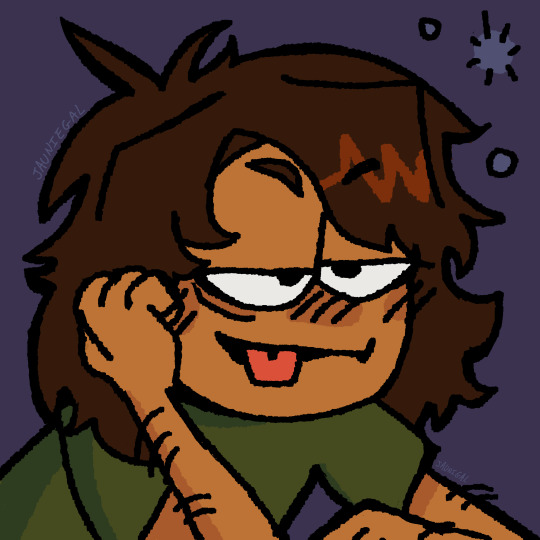
Egwene Terra, ghost hunter extraordinaire with the survival instincts of a horror movie protagonist <3
#can you tell I was using a clvin amd hobbes panel as reference lol#she's a character from an rp I'm in and she's so much fun to play (and I am very normal about her)#art#uhh#doodles#idk what else to tag this#oc#is that a tag?#ok ok I'm done#*cAlvin and hobbes oops too lazy to rewrite it oh well
1 note
·
View note
Note
Who was Paracelsus?
Paracelsus was the screen name of Philippus Bombastus Romastus Fantastus Supercalafragalisticexpialadastus von South-Stuttgart-Next-To-The-University-Cafeteria-With-The-Zig-Zag-Roof. His name Paracelsus literally means "Better than Celsus." We do not know who Celsus may have been, but the name is likely a reference to St. Jerome Para-Ezra of Baton Rouge, who was known in his time to have been far better than Ezra.
Paracelsus invented many of the medical techniques used from medieval times to the modern medical revolution, including bleeding, leeching, exsanguination, draining blood from the patient, and ultra-hemorrhagic-cleansing. He also coined the phrase "Only the dose determines the poison," as well as its corollary, "You can eat anything, just some things you can only eat once," and the less impressive but better known, "He who smelt it, dealt it." This was all considered an advancement over the old theory of bodily humors, which is why Paracelsus's friends all said he was a humorless bastard, or so he kept claiming.
Paracelsus was married in a Rosicrucian ceremony based on the Chemical Wedding of Christian Rosenkreutz, which was of course preceded by Chemical Engagement and a Chemical Romance involving a black parade, the theatrical faking of several deaths, and a great deal of sodium (a mass scientifically abbreviated as Na Na Na (Na Na Na Na Na Na Na Na Na). To whom he was married is a matter of much debate, with potential spouses speculated to include Shakespeare, Queen Elizabeth I, Queen Elizabeth II, Martin Luther, Galileo, Ivan the Terrible, Thomas Hobbes, John Calvin, Catherine Di Medici, the Popes Alexander V-VIII, or possibly all at once.
Paracelsus died in the 1540s after suffering a minor splinter which he treated with his own experimental technique known as "setting the patient on fire and stabbing him with a fork in his balls until he barfs then laughing at him." He was then cremated with his urn displayed at the University of Hohenheim for several centuries, until he was accidentally misplaced during an American tour and is presumed to have been used as ash in some Humboldt Fog Cheese, which was considered an affront to his Swiss heritage.
Also he apparently invented Zinc. Good job.
433 notes
·
View notes
Text
I think Dazai's backstory is really cool in how, despite having more information about it than most other characters, majority of his life is just one giant noodle incident.
Yep, that's the line I'm going with as an introduction to this analysis. Just bear with me.
To start off, for those who don't know, the term "noodle incident" originates from the (amazing) comic Calvin and Hobbes. In it, the whole idea is that Calvin did this unspecified thing in school that involved noodles, but it's never confirmed what exactly happened. It's only referenced in passing, and it is clear that it was not good. Applied to general fiction, the term Noodle Incident refers to an event that is often referenced, but never clearly explained, and what is important is the characters' reactions and feelings towards it. The principle idea behind it is that imagining what said incident could be is way more significant and impactful than anything it would actually be if it was said. It's not the event that's important, but the effects and responses to it are. *for more info, I recommend Overly Sarcastic Productions trope talk video about it*
Now, how this plays into Dazai's life is that, while it is extremely evident that he likely has a horrible, tragic backstory, we never really get to see much of it. The earliest we are introduced to him, he is already suicidal, and he has lost most in hope in existence. These feelings are tempered a bit when he first joins the Port Mafia, but they come back all too quickly. And while you could argue that him being in the Mafia is a large contributor to his depression,the main reasons why he seeks escape clearly transpired before he ever met Mori.

Dazai was already trying to commit suicide at fourteen, which is how he met Mori. Something happened earlier in his life, but we don't know what. Asagiri himself says that he left Dazai's core, the reason he wants to die, vague on purpose. We aren't given many details, and honestly, we aren't given much backstory to it either. The two biggest hints that we get is when he is speaking to Odasaku. First in The Day I Picked Up Dazai, and the second from Dazai and the Dark Era.
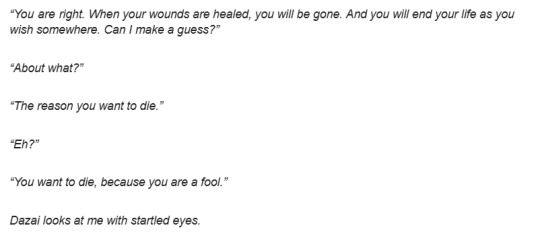
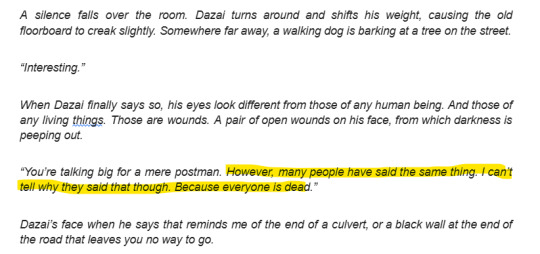

We have no idea who or what Dazai is referring to. From all that we have seen, all the backstories and light novels we are given, the only people that we know of whom Dazai actually lost were Ango and Odasaku-for Ango, it was that special friendship, and Odasaku, it was his life. And even so, it isn't much of an explanation, because he was obviously suicidal before he met them, as evident from how he speaks to Odasaku, and losing them wasn't a catalyst for Dazai's depression. (As a matter of fact, it was actually the first step towards improvement, but that's a different analysis).
Yet for how much we don't know about Dazai's life, I think it's done in such a way that it doesn't really matter. It's a noodle incident, in that sense. Because it's not about the events that actually transpired, it's about how that affects Dazai and the way we see him. Don't get me wrong, I would love a full, confirmed backstory, but Asagiri doesn't seem to intend to write it, and that makes Dazai's character so beautiful. It's also one of the reasons why the dark era, especially the light novel, is so tragic. Because yes, you can argue that as far as tragic backstories go, losing two friends isn't near the most awful, especially not in this universe (I'm not trying to play the "which character has more trauma" game, but compared to, for example, growing up in an abusive orphanage, it's relatively not as inherently tragic. That doesn't make it any less horrible though). But the point of the backstory isn't just to explain the reasoning why things ended up the way they did, why Dazai left the Mafia, boo hoo his friend died, but Odasaku and Ango represent everything in Dazai's life, everyone from his past we never got to meet and I'm not sure if we're ever going to. They symbolize all the things in his life that mattered to him, everything he never wanted to lose but did. The last scene in the bar, where the three of them meet up for the last time, Ango leaves, the picture with the three of them laughing and smiling, the whole thing is meant to serve as a microcosm for Dazai's life as a whole. That he feels he's always going to lose everything, and that's why he wants to die. We don't get details, we don't know the specific events, but we're left with the emotions that gives us an important glimpse into this character's mind, more than his life, and that's what makes him such an interesting character that's left open to interpretation and analysis. We aren't privy to the tragedy, but the aftereffects of it. And, almost as if to prove the point, Odasaku dies the next day. Right after Dazai says he always loses everyone, further cementing the idea that there's almost a curse surrounding him, a void of loneliness that may never be fulfilled, which is as much as Odasaku tells him when he dies.
Whatever happened in Dazai's life before fourteen was probably something horrible and tragic. Maybe he had a family. Maybe he had other good friends. Perhaps he even believed in the goodness of life and humanity. But what's really cool about the way he's written is that the exact events are not important nor necessary to understanding his character. His life is one big noodle incident, yet because of that, we're able to glean an almost deeper understanding about him, by leaving the details in the dark and exposing only the raw, humane emotions left behind. The most important part about any backstory in fiction isn't about what actually happened, it's about how does this affect the character now? What lasting impact did it leave on them, and how is it evident in the way they interact with the story in the present? This is something that Asagiri nails on the head when it comes to his backstories. And I think the lack of clear information about Dazai's backstory, yet all the information we do end up getting about him, is one of the reasons why Dazai is such an interesting and intriguing character in the series.
Thank you all for you time. You may now return to your procrastination.
#Yeah I've got tons of work to do today#so I naturally wasted time writing an analysis instead#that logic checks out#anyways#I really like Dazai#I think he's a really cool character#misunderstood as he is#we have so many light novels about him and he's still so mysterious#this was just something that occured to me reading the day I picked up dazai#bungou stray dogs#bungo stray dogs#bsd#bsd dazai#bsd analysis#bsd dazai analysis#the day I picked up dazai#dark era dazai#dark era bsd
153 notes
·
View notes
Text
Hey Look At This Comic: Quincy




I can't remember the exact jumps it took me to get to Quincy. I know the starting point: Randy Milholland's guest appearance on Behind the Bastards for a couple episodes on Dennis the Menace. guests on that show tend to be a bit of a live studio audience, there to go "wow" and "yikes" and "[noise of discomfort]" at the right moments. not Milholland, who knows his comics history. boy, I would listen to a whole podcast of him just talking about newspaper strips! anyway, I don't think he mentions Quincy while talking about integrated casts in newspaper comics, but someone he did mention sent me off on a search and someone else mentioned Ted Shearer's Quincy, and well.
you can see, right, why this comic Got Me so fast? what a cartooning style! I'm not going to dwell on Shearer's history--you can read the Comics Journal article on him just as well as I can summarize it. I want to talk about how Shearer draws.
it's hard to do that without reference to other comic strip artists, in particular, standing as foils for Shearer's style. Ernie Bushmiller of Nancy fame is maybe the paragon of an ultra clean iconic style, where everything is almost like the platonic cartoon of what it is. (I've seen Schultz placed in this tradition as well.) not Ted Shearer's work. everything's got little flourishes and elaborations and bends and variations in outline. his comics jiggle. there are times when I'm not totally sure at a glance what his marks are meant to represent, which is a problem if you think the highest calling of comics is to relay information clearly, and a lot less of a problem if you're in love with the sheer artistry of mark making. look at that snowball fight comic, for example, and the wild mess of lines, or the way Quincy's shoes and socks are sketched, in the last panel of the letter to the president comic, with just a few confident pen blotches and a bunch of negative space. even when it's economical, it somehow feels so unsatisfied with the schematic, always searching for a way to make the objects feel a little off kilter, a little dynamic.
check out that first strip there, the one about where Quincy's granny frets over the neighboring building getting demolished, because it's crucial infrastructure for her clothesline. I just paged through a collection of Bloom County I have cause I was like, well Berkley Breathed has pretty dynamic panels too right? nope! Bloom County has a dynamic brushed style that feels similar to Shearer's style, but the panel compositions and the arrangement of characters and camera and environment are typically much more static. even Calvin and Hobbes, aside from the often completely crazy sunday strips, tends to have compositions that might employ a closeup or a distance shot, but tend to have relatively cohesive shots. this three panel strip starts with a panel where Quincy, instead of standing static, listening into the phone call, seems to pop in from the left, tie fluttering with movement. (also, scope the nice tilt on that lampshade, echoing the angle of Quincy's body!) panel two seems to pull out to an unmotivated ultra long shot, that not only gives us the apartment buildings but the fence partly blocking the view! Quincy's environment is so packed that there's no room for the kind of clear view of a building you might get in a Nancy strip. and then the point of that long shot is revealed in the final panel, a CRAZY dutch angle on the two leaning out the window towards the other building, as Granny reveals the other side of her washing line is going to get torn down. to accentuate this, the sheets on the line billow, again at an angle counter to the window, Granny, and Quincy.
Shearer seems never content to just have a series of characters in situations talking to each other. his viewpoint is always swinging around, his characters always turning to show new angles of themselves. the letter comic here is the most conventional strip of the lot and even this has only two relatively similar poses. all three standing poses are in wildly different positions and angles, front, then spinning to the side, then back, tilting left, tilting right.
he also has this tendency to have characters pop up almost as though they can see the camera. it's not enough that a straightman in Quincy should turn to the audience--they tend to pop towards the foreground. in that clothesline comic, Quincy doesn't look to Granny but to us, as though inviting us to join him in wondering about the phone call that has Granny so worried. in the composition of that circus comic, Shearer finds room for the characters, despite the size of the animals, at the borders of the comic, and is willing to embrace way more pronounced perspective than I'm used to seeing in daily gag strips to do it. look at that kid just sorta peeking over the bottom edge of the frame in that last panel! there's other comics of his where inexplicably another kid in Quincy's class, for example, will just pop their head up in the last panel, somehow accentuating the punchline with their non sequitur appearance. like real kids, Shearer's kids are unruly. like a real poor urban area, the very material of the landscape is unruly.
that TCJ article lays out what Shearer's motivation may have been, for such a vibrant and lived in strip:
"My first idea is to get people to like Quincy, to get them involved with the character, and then they can see for themselves the broken-down home, the torn sneakers, etc. Then perhaps readers will say, ‘Gee, maybe we can help.’ Or even the poor white can say, ‘Gee I went through this same thing myself.’"
that approach can only work because of the detail Shearer's panels overflow with. one more comparison: don't Shearer's landscapes sometimes feel a bit like George Herriman's wobbly, shape-filled landscapes in Krazy Kat? just, less weird cacti and more scrungly fire hydrants and snaggle-toothed fences. the move from panel to panel doesn't always make diegetic sense, much like the landscape moves around Krazy, but it's so lush that in total it creates a place that feels lived in, enough that it still connects with me 40 or 50 years later. that seems a testament to Shearer's strategy, and probably has some lessons for the Clarity of Communication school of comics theory.
it all adds up to a work that should be in the pantheon right alongside someone like Bill Watterson. I don't think I've ever heard anyone talk about Shearer, though. the broadest history I have--Harvey's Art of the Comic Book--doesn't cite him; nor Wolk's Reading Comics. like a lot of histories, Gardner's Projections loses track of newspaper strips sometime between the rise of Stan Lee and the rise of Comix With An X. some of that's the way the history's been canonized, but some of the way the history's been canonized is surely due to institutional racism and the pinning of the modern Art History of Comics on white men like R Crumb.
what Quincy deserves is a way of following it now... but that's not an infrastructure I can imagine anyone is interested in building. sites like comics kingdom or gocomics have snubbed rss technology for presumably the same reason social media increasingly gates all content from non-users: gotta juice the numbers and make sure direct access is the only business in town. which is sorta bizarre when it comes to a strip like this because who is signing up for a comicskingdom account, sitting down, and reading through a decade of Quincy strips? if they're already just putting the lot online for free (which, hey, I'm grateful for that, especially from a historical access perspective!!), why not set up a way to cycle through that history in a feed, shipping out the strips in the format they were meant for: something you'd see daily? but, I'm the weirdo who thinks basically the whole internet should be embracing a more broadcast syndication model. at least the comics are readable online, which means that maybe bit by bit Ted Shearer's work can get the wider cultural attention something this virtuosic deserves.
this post originally ran on Cohost on Jul 31, 2024. you can read more reviews in the Hey Look At This Comic tag and support me on Patreon.
#Hey Look At This Comic#comic#quincy#Ted Shearer#comic review#comic strip#comic recommendations#comic recs#newspaper comics#black cartoons
67 notes
·
View notes
Text
it's a bit annoying when people call me chronically online because this is very sincerely homegrown pretension. i've only been on tumblr from late 2021 onward i have ALWAYS been a 7.0 richter scale pedant. rarity was my favorite my little pony and i used to research the meaning of every reference i didn't understand in calvin and hobbes and in my greek mythology phase around age eight i was accidentally introduced to psychoanalysis which was frankly the beginning of the end why are you all so afraid of women's accomplishments
85 notes
·
View notes
Note
Tracey, hi!! 🩷
I wanted to ask this for SO LONG now, how do you always make your comics look SO great?? Like, it's amazing HOW 🔥 TEACH ME
How do you decide where to put each little section of a panel, what form they're gonna be, how many sections are there in one panel, etc?? Ik it depends, but just like, usually (sorry if this doesn't make sense TvT) I already started experimenting with it, but I always find myself coming back to your blog for reference 🥹
Thank you for answering if you do, have a lovely day/night!! 🩷🫶🏻
Lucy!!! 😭 you’re so sweet you'd think so and to ask, if anything everything in my comics is a 'lets see what happens if I do this' because I’m just experimenting too 😆 I made some post of my processes I'll link below. I’d LOVE to see anything you’ve worked on though 😍
Post of processes used in my previous comics
Post of page layout processes
The only thing I can say is KEEP EXPERIMENTING! Just draw the actions of your characters without thinking you need fancy panelling. Look to works and media’s that you enjoy, whatever that could be - like a visually appealing still frame from a film, a layout of a particular story sequence. Even just copying something for your own practice is a great way to start and use it as a basis to make into something of your own!
The recent art evolution tag game I really loved seeing everyone's influences and how it informs their art styles. I guess to think of how to then configure that art into a comic can seem daunting but you just got to try and go for it. Of my recent comics, Burdie is a new range of story for me as I've not created anything involving ships like, AT ALL! so its probably been the scariest but also the most amazing fun
am sure you'd have yours but am just attaching some of my biggest comic influences



Shaun Tan - extract from The Arrival, Bill Watterson - Calvin and Hobbes and Akira Himekawa - Twilight Princess (this manga being my biggest you can see a lot of my page layouts similar because I love it so much)
Hopefully those previous post links might give some insight to my processes of panel and page layouts but something I hope not to overwhelm. Why I love Calvin and Hobbe’s it’s clarity in character actions within a few frames but ultimately it’s your story you want to tell so present it in anyway that is true to you <3
#thank you for this ask it got me thinking a lot#and it probably doesn’t answer but will try and elaborate if there’s anything specific#I’m sorry it took to long to answer partly trying to think of a simple answer which is far from one 😅#and Jeezo what a week but wishing a happy Friday#not my art#just attaching for art examples
28 notes
·
View notes
Text
Let's take a look at the ninth art...
Given Asterix and Obelix has been getting popular again, I thought I'd do something I wanted to quickly write down for a long time - some posts to introduce those unfamiliar with to the world of... BD!
"BD"? Bande-dessinée. The French word we use for what Americans call "comic books" or "comics" or "graphic novels". Technically speaking, BD can cover the entirety of European comics production, but traditionally people refer to the "Franco-Belgian BD", "la BD franco-belge", as the heart of the European production was formed out of the industrial duo of France and Belgium.
Now, why would you or I use this obscure non-English term "BD" or "bande-dessinée"? Why not just say "European comics" or "French comic book"? Well... Why do you use "manga" and not "Japanese comic"? That's the same thing. Bande-dessinée works a lot like the American comics yes, and in fact, when I took a class at university about the history of BD, the teacher kept referring the theories of Will Eisner and Scott McCloud - BD, like comic books, are two manifestations of the "sequential art" as a whole... However, BD has a very different publishing process, a different historical evolution, a different social reception and cultural context than comics, and so it earns the right to have a specific denomination to separate it from American comics, the same way Japanese mangas are called "mangas". In fact, manga, comics and BD form the holy trinity of the sequential art, the three main manifestations of this specific medium - on one side Batman, Calvin and Hobbes, the Marvel comics ; on the other One Piece or Akira, and in the middle Tintin and Asterix and others...
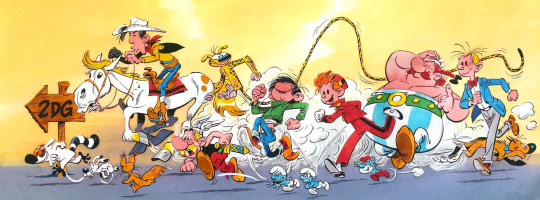
BD received various other names, from the derogatory to the glorifying.
A derogatory name? "Petits mickeys" (small mickeys), alternatively spelled "petits miquets" (small miquets, a francization of the term apparently from Pascal Oury). This term, from the 60s and 70s, was used to refer to BDs under the angle of low-quality, of "popular", "low" works. "To draw little mickeys, to read little mickeys, to make little mickeys". The term was also used, in a lovingly ironic way, out of self-mockery, by various BD creators such as Goscinny or Gotlib (today you can hear people say this term is tied to the Pilote and Fluide Glacial generations, 60s-80s). Some wonder if it isn't Sempé who made the term "mainstream", through humoristic drawings he made showing how people asked him if he was the one draing "little mickeys". Of course, this is an obvious reference to Mickey, the character from Disney, but it isn't just some sort of "Americanization" thing... The reason Mickey became associated with BD was due to "Le Journal de Mickey" (a famous French comic-magazine), which has been in France one of the historical outlets for introducing and developing the BD in France. But as a result, it led to the perception of BDs as simple stories, as childish things aimed at a young audience, and at "Mickey-adjacent" (and thus Disney-adjacent) products.

A glorifying term? Le neuvième art, "the ninth art". This famous and common denomination (which ranks the BD production to the rank of "art") is based, not on the "seven arts" of the Middle-Ages, but rather on a different system of art classification... You see, in the 19th century, a certain "art hierarchy" was popularized (by Hegel). It deemed that there were five main arts, which in rank of importance were architecture, sculpture, painting, music and poetry. However, after Hegel's classification became popular many authors and thinkers started to add their own arts - in the 1920s, Ricciotti Canudo notably added the "sixth art" (dance) and the "seventh art" (cinema). Though not everybody agreed on what was what - for example, while today the sixth art is "dance", for quite some times it was "photography". And while Canudo added the sixth and seventh art, he had his own concept of the five arts - for him it was poetry, music, theater, plastic arts and eloquence/rhetoric.
Anyway, BD soon became the "ninth art". Morris (creator of the "Lucky Luke" series) and Pierre Vankeer wanted to officially call BD the "eighth art", but they discovered the term was already taken - Roger Clausse used it for radio in the 1940s, but it quickly became a common term for television as a whole and englobed within itself photography... So, Morris-Vankeer chose the "ninth" art for BD and, in a strange coincidence, on the very SAME year Morris-Vankeer published their denomination of "ninth art" (1964), Claude Beylie published his own article deemed BD the "ninth art". (And also, little historical trivia, the term existed by the 1920s but it was to designate gastronomy, and it never took off).
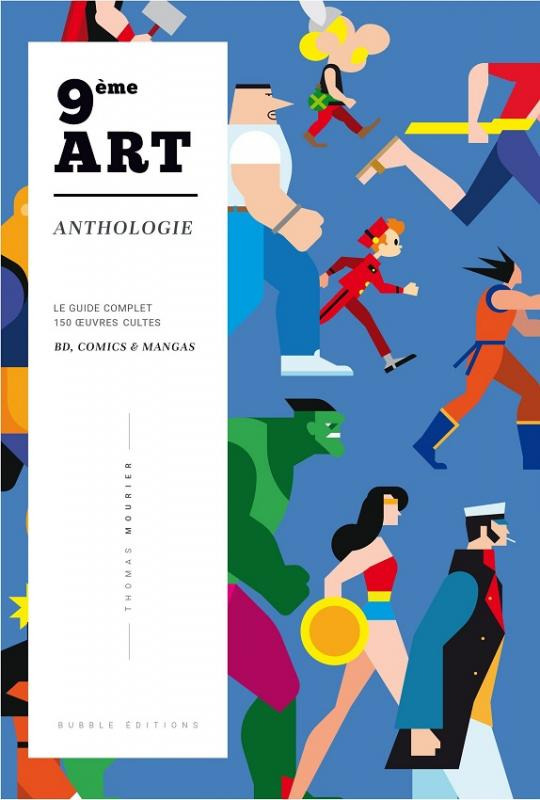
There is also quite a big debate over whether BD should be considered literature or not. It is primarily a narrative with prominent illustrations? Or is it primarily a visual art with some narrative stuck to it? What is more important, the drawing or the text? Is it closer to books or to paintings? Do we focus on the visual logic and the aesthetic, or the storytelling devices? It doesn't help that BDs come in a wide variety, from products very thick and heavy with text, to BDs without any text. From Boulet to Edgar P. Jacobs, from Les Cités Obscures to Blake et Mortimer...
Without going back to the Egyptians and their hieroglyphs, the class I took about the history of BD did point out how the roots of the "sequential art" in France could go back as far as the stained glass of churches, and the very famous Bayeux tapestry.
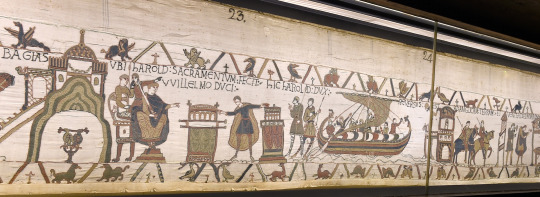

But the story of BD really begins with Rodolphe Töpffer, the man who is thought as the inventor of BD as a whole. You might know of him if you looked into the history of comics books because he is also thought of as the grandfather of American comics. What he wanted to create, first and foremost, was what he called "littérature en estampes" (literature in prints, literature by engravings). He was coming from the world of traditional books and novel-publishing, and thus had a very literary approach to it all. He wanted a form of literature where text and image would co-exist as equals, united for satirical and humoristic purposes. Because that was one of the main features of his work - to have caricatural characters, with exaggerated features, placed within comical situations.
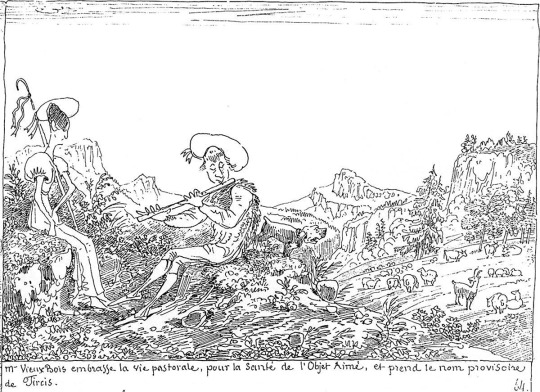


With Töpffer, we find a true "balance of the sequential art". Because the images are clearly dependant and "submissive" to the text, in terms of narration and storytelling, but in return the visual has a much larger part on the page and is what catches the eye immediately. As a result, we have a proto-comic which relies heavily on the text, but where the drawing is what makes it interesting in the first place - and the visuals are needed to appreciate what the text is saying - and these texts usually explore the logic of mismatching, discordance, and absurdity.
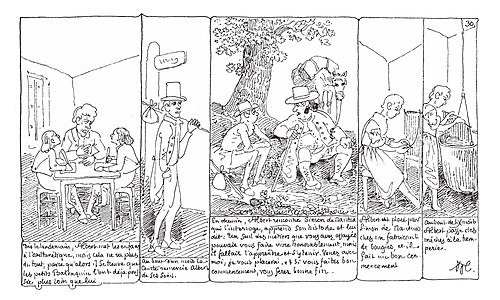

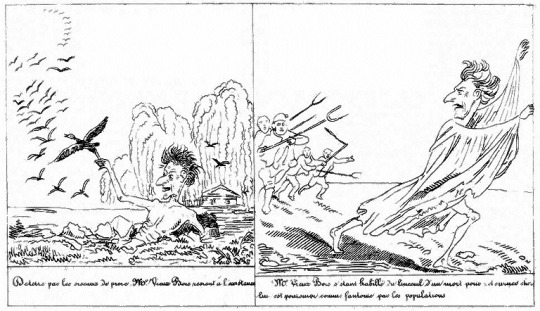
Töpffer's work spread throughout Europe, and even reached the USA... And yet never gained any fame. It was not a huge success, it was never a best-seller, in fact it sold in small quantities and limited editions. And yet, it still had a big influence over the various illustrators and cartoonists of the time, and gained a small celebrity in the world of caricatures. But for Töpffer to REALLY become famous and a public figure, we would have to wait for when people started studying the history of BDs and comics...
And what Töpffer changed, through his work, was the idea of these doodles and cartoons existing on their own. Given the development of comics always deeply relied on the developments of the printing industry, they rarely could exist "alone" - unlike text, printing comics required more machines, more supplies, more technique, more effort, and so they usually appeared as caricatures within daily or weekly newspapers, or as comic strips to illustrate a text, they appeared within places of recurring, regular publications that were however not their "own". The BD industry grew out of this logic of recurring, repetitive publications, and still kept a format of "serial". But Töpffer published his little comics on their own, within their own books, without anything else but them - they were sold for themselves. And that's how it changed things.
The BD also primarily began as a form of... "degraded literature", so to speak. It was seen as a storytelling form perfect for almost-analphabetical people and for people with reading difficulties - first of all being children. The BD fed from this concept developed in the 19th century of "youth-literature for young readers", this idea that children could have and deserved their own books separate from the readings of their parents (Jules Vernes notably played a big role in creating this "literature for children" in France). This, tied to how crude, fast-made and easy-to-reproduce the BD drawings were at the time, resulted in a general perception of BD as a form of "futility". BD was there for humoristic satires, funny caricatures, children publications. It can be compared to how the "mangas" were originally drawings of a "low", "mundane" daily-life, opposed to the "high" and "real" art of drawing landscapes.
And this initial "futility" explains a LOT about the history of BD and how it evolved. The first step of the BD history was to prove its "interest" and its "utility", by becoming a "useful" thing, by turning into a tool of pedagogy or a "good" form of entertainment. And once the BD became a legitimate, mainstream, mass-produced "classic" thing, then came a second era of counter-culture, where BD became more experimental and more mature, reaching out for an adult audience.
The "periodical" publication of BDs by "chapters" or "issues" was not truly preserved. Unlike American comics and Japanese manga, where the serial chapter-publication or the periodic-issues release is still a foundation of the industry, the BD industry ditched it all and relies rather on the publication of full "volumes" or complete "collections", as a full book with a solid cover. Before it is true that the income of BD creators came from the "perodics", with their work only being bound in a single volume, a "hardcover", as a "bonus" or a "reward" that confirmed the success of the series - but today BD relies almost exclusively on the publication of full volumes.
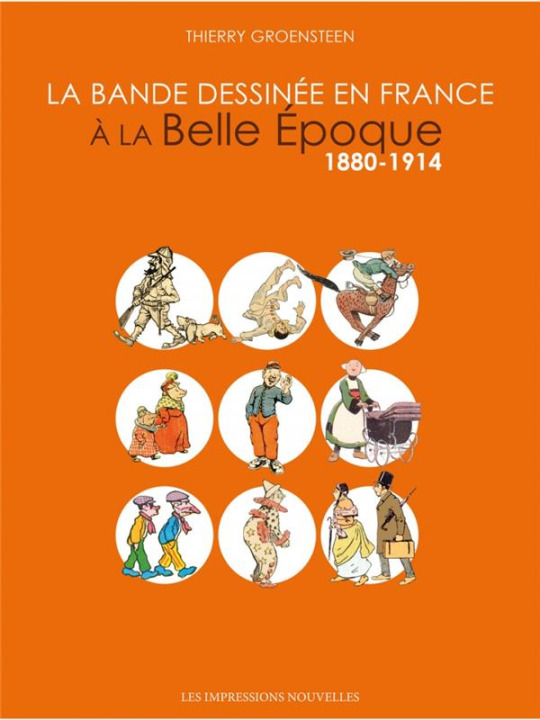
After Töpffer, the "littérature dessinée" (drawn literature) affirmed itself more and more, through satirical caricatures and humoristic tales. It never became the main production of artists - they were primarily illustrators or photographs, and they only did proto-BD as an aside. You had Cham, who took a lot after Töpffer, you had Nadar, who caricatured the mid-19th century politics, you have Gustave Doré too, yes THE Gustave Doré...

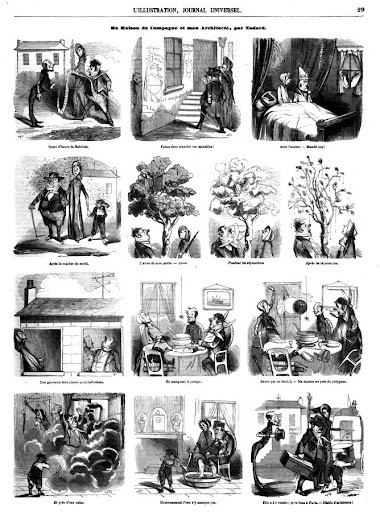
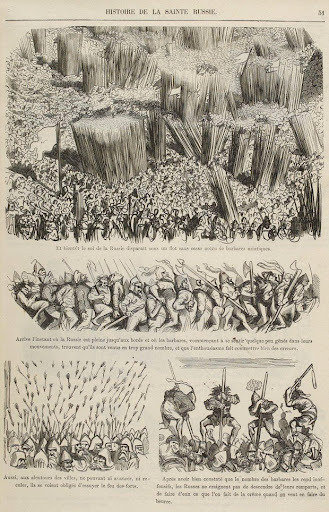
But the next big turn, the one that changed the "generic humoristic stories" into a "specific illustrated literature for children" was "La Famille Fenouillard" by Christophe, considered one of the first real BD of France (1889-1893). And again, we find here a specific balance between text and image. You have a LOT of text, that is a big dependance on the text - it is there that all the story takes place... But the drawings meanwhile are very attracting, very insisting, because they are incomplete scenes and visual enigmas that encourage the reader to check what they are about. The image attracts the gaze, creates the curiosity, the wonder, creates the question, whereas the text offers the answer. We are still in quite simple, not complex stories, but they play a lot on dichotomy - for example the drawings offering joyfull, happy, positive situations, that get more shady, more dubious if not dangerous once you add the text to them.


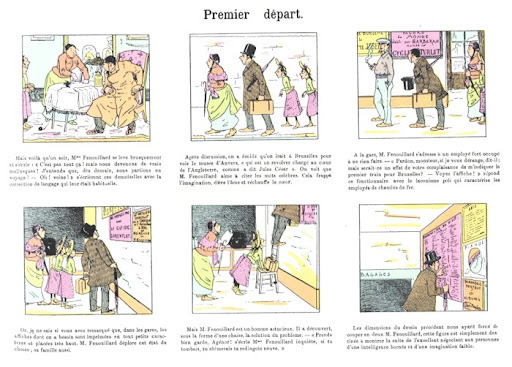

While I speak a lot of France, Germany has its own things going on aside - most notably, it developed what would become a very common genre in European BD, the "petits garnements" genre. Stories of brats, mischievious boys and little devils - such as the classic "Max und Moritz" (1865). This resulted in a wide fashion of duos or trios of prankster-heroes, that would create a lasting associated in culture between "childhood, youth" and "transgression, disobedience, trick". But here, we are closer to an illustrated tale rather than a "true" comic.
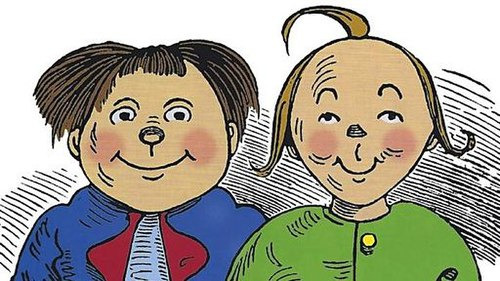

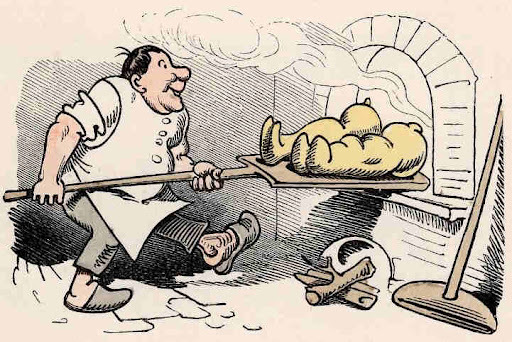
For more about the history of BD, see you in the next post...
#let's explore the ninth art#ninth art#bd#bande-dessinée#bande dessinée#comic books#comics#history of comics#history of BD#french history#france#french comics
21 notes
·
View notes
Text
WELCOME
she pinned on my intro til i post heya. feel free to read through my intro post... if you dare. have a swag day unless you bathe in bigotry, in which case i hope you bathe in different things in the near future because you smell horrible and no one likes you. also im a minor, i have no problem w/ adults following me or anything, just stating upfront in case it makes anyone uncomfortable. if you don't want minors interacting but i accidentally followed you, im vvvv sorry and likely just missed it because im stupid, feel free to block softblock etc
please note: please do not dm me asking for donations. i am sorry, but i am unable to donate to campaigns as i am a minor, currently have no source of income (will likely be years until im allowed to have one), and my whole family is also struggling pretty badly financially rn. i apologize deeply and pray you find peace and safety, and i will try my best to share campaigns when i can but beware my blog is not very popular and you’re likely better off going to someone else. again im sorry.

❂ Greetings!
✦ im Blue da ba dee da ba dai, or perhaps Bingle or Bingley if youre feeling creative. you could also just call me mishmash or webster or smth idc
✦ they/he/ey/cos/it, primarily they/he.
✦ transmasc enby, additional gender labels = genderfuck/genderpunk, androgyne, anarcho-queer. buncha jumbled shit
✦ orientation = panromantic, demiromantic, grayace.
this blog is my main and only blog, so dont expect organization, but i will trigger tag when possible/requested to.

❂ Additional info
❂ Tags legend (some tags i may still be going back and sorting through, apologies for that)
#bingletxt (posts that are mine and no one else’s)
#go fund them (donation campaigns (may not always be on the gofundme website, but just all donation campaigns in general). please look through this tag and consider donating if you have the time/resources)
#sick art, #godly art (other peoples' cool art, used interchangeably, one isnt inherently better than the other it's just based on vibes)
#vent post (my vent posts, please feel free to filter this tag, i may talk about heavy/personal subjects)
‼️Note: i may reblog posts with nsfw/suggestive content or subject matter (for example, medical diagrams of private parts for trans reasons, artistic nudity, etc), ship posts with suggestive allusions (almost always in a comedic way), or make/reblog suggestive jokes. this is because i have the eternal humor of a middle schooler who giggles during sex-ed. if you dont wanna see any of it i tag with #nudity, #artistic nudity or #suggestive. (plsplspls tell me if i forget, or if theres anything else you’d like me to tag, id be happy to ✌️)
❂ Fandoms
some of these i havent consumed in their entirety, ill mark them with purple if so
Welcome to Hell, The Owl House, Ace Attorney, Madoka Magica, The Amazing Digital Circus, Amphibia, The Amazing World of Gumball, Beastars, Cherry Crush, I'm In Love With The Villainess, Ramshackle, Heartstopper, Deltarune, Undertale, Bluey, Mob Psycho 100, Calvin and Hobbes
stuff i wanna consume but havent gotten the chance to
Sonic franchise (games + movies), Garfield (yes the cat)
❂ Stuff i don’t appreciate and will most likely block you for
i cant really forbid you from interacting with me at all costs and think the concept of dnis is kinda meh, bla bla bla, but if you support/fit the description of any of these and still choose to interact, im prob gonna block you so be forewarned:
✘ pornblog-related anything. i am a minor, dont want to date/fuck you, and you will be blocked (not in reference to blogs who occasionally post/reblog nsft content, im primarily referring to pornbots here)
✘ Conservatives/right-wing/MAGA imbeciles, centrists, homophobes, transphobes, zionists, antisemites/islamophobes (real ones, not Palestine supporters), radqueers/radfems/TERFs, predators, pedos, forced birth supporters, anti-neopronouns, anti-therian, beastiality supporters, sexists. (self explanatory)
✘ pro-sh or pro-ed blogs. (you deserve help, please do not encourage others to do it.)
————————————

blinkie credit: blinkies.cafe
my pinterest
my ao3 (dont get too excited i havent posted anything yet)
#intro post#intro pin#introduction#pinned intro#blog intro#introducing myself#intro#pinned post#bingletxt
25 notes
·
View notes
Note
Yeah that was me(the demetrius thing) and YEAH YOU GOT IT. IM romancing Sebastian rn and like he is not worth the hype to me at all. He's rly fun as a character, dont get me wrong, but so much of his dialogue is complaining or pointing out specific stuff that it makes it hard to find things to latch onto. With Shane, you get that little hint of change by his 2 heart cutscene, but Sebastians just makes him feel like a jerk, especially when the player has no context about his work at all up until that point. In addition, some of his complaints just have no real basis. He's not being forced to live in the basement, he clearly has plenty of space for his interests and work bc who else is using the garage, Marus mini work area is straight up outside, and even the mentioning of Demetrius making him get rid of his snow goon makes perfect sense considering. Its a Calvin and Hobbes reference. It was probably some guy dying brutally and tbh, when you have a homeless guy who's experienced a lot of implied violence for his lifestyle before right outside your house? Im giving that one to Demetrius regardless sry dude. Even his questions feel weird, bc he's rly the only character who judges you for what YOU like instead of for. Straight up insulting them or for being super judgy yourself. Also despite Abigails genuine friendship with him if you either marry her or are high enough relationship with him he'll completely shut her out of his list of friends despite them still hanging out implying that he really only sees her as a potential romantic partner and that you either take that away from him or he gives up on her and that just. Really rubs me the wrong way. I do enjoy him as a character but when his dialogue has so little variety and he purposefully cuts off parts of his friend group and then complains about how he feels while taking no responsibility for any of his actions(which, I get being that basement dwelling antisocial kid into nerd shit I do but if he's not even giving the other members of his family a chance to interact with him or see what he works on, of course he's not gonna feel like he's getting any recognition from them) he just feels so overhyped. White emo twink bias at its finest tbh but ill admit his winter outfit is way too cute somehow. Gru ass bitch/pos
I dunno maybe when I get further into dating him it'll feel better his 14 heart cutscene is the cutest FUCKIN shit tho and one of the only 14 heart ones that doesn't feel tacked on imo so I'm excited for that
.
16 notes
·
View notes
Text
I totally forgot I wrote this out by here are my opinions on what comics the marauders would be into except it’s probably not that accurate and 100% not going to even be close to time period accurate.
I’m not much of a super-hero comics person so my knowledge is limited, and all of my knowledge of comics really in general comes from shit i was into growing and shit my dad was into growing up in the 80s so. Thats what this is based on. Mostly based on my father. Or me projecting.
James - big superhero fan, but in a cool way. Obviously. He loves spiderman (he’s right) and will buy every new spiderman volume from the comic shop near his house. Probably has a spiderman poster. I think he likes hulk comics a lot and I’m getting Thor vibes. In his mid-late teens he gets really into Wolverine. He’s a Superman guy and he does really like Batman but like doesn’t everyone?
Remus - I feel like he liked more than just hero comics, probably had one of those boxes for comics but it was mostly empty. He buys comics when he can but mostly gets a lot of his from trading with James. He’s a huge fat Batman nerd and he likes ghost rider and x-men. He rlly fw daredevil also. Certain Thor comics he really likes and the new mutants also. He’s like a huge nerd and knows a bunch of weird lore. He won’t talk about it unless you ask tho. He likes comics more than like novels because he is dyslexic ❤️ I think he was always a fan of the news paper comic stripes and grew up reading Calvin and Hobbes comic strips and adored them. He likes Alan Moore stuff obviously, like watchmen, v for vendetta, etc. He fiends for sandman also and I think he likes doctor who comics a bit. If u care I know it’s way late but I think he would’ve liked The Goon. I’m definitely projecting with some of these.
Peter - big comic nerd. Loves Batman, spiderman, and wolverine. He likes fantastic four and x-men a lot. He’s a teen titans enjoyer. He trades comics with the guys a lot and loves it cause James always has the cool shit, but Pete probably has like one comic that he won’t let anybody borrow or nothing and treats it like a living child. He has many nerdy discussions with Remus and arguments with James.
Sirius- he’s not as into comics as the other guys, but not exactly for lack of interest. I feel like his mom was one of those that thought comic books were for dumb kids and she just never bought him any and he never really asked for them and was surprised when he found out how into them his friends were. He probably didn’t really get into comics until he was like 15 but when he did I feel like he loved daredevil, batman, ghost rider, wolverine, spawn, and Elektra. He likes Wonder Woman and the x men. Also likes Sandman.
Very important note: James, Remus, and Peter are literally all in love with TMNT comics. I don’t make the rules. They talk about and reference the turtles all the time and it was actually a bonding point for them in the early days. in second year Sirius revealed he didn’t know what they were talking about, and when the boys proceeded to explain the premise of teenage mutant ninja turtles, Sirius said it sounded like the dumbest thing ever and Remus didn’t talk to him for the rest of the day.
These are super basic and not well-informed headcanons but I’m having a lot of fun projecting. If you are a big comic nerd and have other opinions, don’t get mad at me cause I don’t care, but please do share your opinions I am very interested.
#umm yeah#i think regulus is really the only of the big 12 who doesn’t like comics at all#well I also think Dorcas isn’t that into them#u know who is really into them? Marlene McKinnon.#she is a fucking fiend for Wonder Woman comics and was probably Wonder Woman for Halloween#marauders#marauders fandom#marauders era#marauders headcanon#james potter#james potter headcanon#Remus lupin#remus lupin headcanon#peter pettigrew#peter pettigrew headcanons#Sirius black#sirius black headcanon
11 notes
·
View notes
Text
About Me
Hello there! I'm Drakmanka, an Asexual, Genderfluid/Non-Binary, plural Dragonkin. I use They/Them pronouns and often refer to myself as "This Dragon".
Current age: 32 years.
Though I am host of a plural system, this blog will predominantly or possibly exclusively be run by me, Drakmanka. My headmates prefer more private settings in which to front and share their thoughts.
DNI if anti-endo, we have nothing to say to each other.
I intend this blog to be PG so it is safe for minors.
Additional info about me and my interests below the cut
My alterhuman identities (that I am confident about) are as follows, in order of importance to me: Dragon, dinosaur, raven, Tigger, demigod (of some sort, still figuring that one out), and elf. I am also questioning a ghoul 'type. I identify as both Therian and Otherkin.
I am also cat-hearted, rat-hearted, horse-hearted, and ent-hearted.
My plural system is primarily comprised of fictive walk-ins, but a few of my OCs have also shown up (this actually makes writing about them really hard with someone actively critiquing my portrayal of them).
While wearing my Human Costume(TM) I drive a school bus and make cat noises at my coworkers (some of whom do it back!). In my free time I enjoy chatting online with fellow alterhumans, working on one of my original stories, drawing (mostly dragons), reading, playing video games, and building LEGO sets and MOCs.
I have two cats: Layden my heart-cat; a grey tuxedo rescue who's been with me for over 10 years, and Jasmine the family cat; a flame-point Siamese who was rehomed to us last year when her original owner had to move to a retirement home.
I've been keeping rats for nearly 17 years now. I'm currently without rats after the passing of my elderly boys Frodo, lost to cancer, and Samwise, who mercifully passed from simple old age. I'm unsure when I will be ready to open my heart to new rats, but I know myself; I go a special kind of crazy without them.
And lastly on the pets front, I keep a tropical freshwater aquarium. It's a 29-gallon community tank. Ask about fish names if you're curious!
Some of my favorite titles and franchises of various media (in no particular order) are: Bionicle, Lord of the Rings (especially the books!), Minecraft, Dishonored, Metroid, The Legend of Zelda, D&D5e, Girl Genius, Avatar: The Last Airbender, Stargate SG1, Star Trek, Star Wars, Dragonriders of Pern, Super Mario Bros, Spyro (the Dragon/Legend of), Calvin and Hobbes, TES Skyrim, The Age of Fire, and Wings of Fire.
Some of my non-media-related interests are: Zoology, Paleontology, Meteorology, electronics, horticulture, auto mechanics, Astronomy, forestry, and Geology.
I also enjoy training my pets, practicing music (I play piano as well as ocarina, and am trying to get good at guitar), language study (I am low-level conversational in Spanish, am attempting to learn Thai, and want to learn German, Chinese, Japanese, and Russian someday), and I'm trying to raise a bonsai tree from seed but keep losing my seedlings.
I collect rocks, rubber duckies, and suffer from an affliction known as bibliophilia which has rendered my bookshelves utterly stuffed. I have a plushie collection that takes up a little over half my bed. I'm also addicted to music.
I enjoy most forms of music except jazz, rap, and blues. My favorite music genres are Alternative, Rock, Metal, World, and Ambient Music.
I live with my Found Family whom I affectionately refer to as my sister, my gramma, and Sensei/grampa.
I am adopted, which definitely makes the way I define family looser than some.
My adoptive mom, I refer to as just my mom, and same with my adoptive dad. I have an adoptive older sister who amusingly is almost the same age as my chosen sister. I have two biological half-sisters, whom I generally refer to as my bio-sisters. I refer to my biological mother as my birth mom, and my biological father as my father. I have never met either of them but I have met my bio-sisters.
I also have step-family: my dad divorced my mom many years ago now (amicably) and she remarried when I was 18. My step-dad is a pretty nice guy, and I also have a step-brother and step-sister (my step-sister is also, amusingly, almost the exact same age as my adoptive sister and chosen sister).
My family situation is a bit of a tangled mess to explain but it all makes perfect sense to me!
When I refer to "my family" I am almost always referring to my Found Family. I don't expect I will make such references often though.
If this data-dump wasn't enough for you, feel free to message me with questions!
13 notes
·
View notes
Text
Last night I had a dream about a "Spaceman Spiff" movie, which replicated the elements from Calvin's imagination more-or-less verbatim without any regard for the fact that, y'know, this was supposed to from Calvin's imagination. No other references to Calvin and Hobbes, I think in the dream I wondered how they'd gotten Bill Watterson's permission.
9 notes
·
View notes
Note
What have been some of your big inspirations/points of education* with your comic work?
*could mean learning resources but also just, good advice you got once or improvements to your workflow you figured out
Thanks for this ask!! :]
I went to the School of Visual Arts, where I majored in Cartooning! A lot of what I learned, I learned from Indie Cartoonist Jason Little and DC/Marvel Editor Joey Cavalieri, both of whom taught multiple classes I've taken (mainly fundamental stuff but there were also some extra classes with them like Jason taught my Digital Comics course and Joey taught my History of Cartooning class). I learned how to draw trees from Jason. And from reading Pogo.
I've drawn a lot of inspiration in my storytelling from both Bone and Hellboy, mostly! Both Jeff Smith and Mike Mignola are masters of pacing in comics, and if you happen to be unfamiliar with their works, I can't recommend them enough. Besides those two, the rich, moody internal monologues of Spider-Man: Blue and Spider-Man: Evolve or Die are things I often think about when it comes to dialogue writing. That and (at least when it comes to writing Rouge's dialogue) my older sister. Just, like, in general. Pay attention to how the people around you speak. It helps a ton when figuring dialogue.
Hellboy is getting mentioned again because Mignola's heavy inks are something I like to look over in order to learn from and improve myself. Hellboy, Carl Barks's Donald Duck comics, Asterix & Obelix, Will Eisner's various works, Calvin and Hobbes ALL have this beauty in their inking that can really inspire. Personally, I'd like to get a bit messier with my inking. Messy inks feel so alive. They're so visually interesting.
For colors, I highly recommend this book. I've read it and re-read it as much as possible. It may be for painters, but cartoonists can and should learn from all kinds of art forms. The works of Moebius were also mega foundational for me in learning how to color my comics. The man knew his palettes and how to not confine himself too much to what's "realistic". Speaking of painters (you may roll your eyes at this one) I'm also a fan of Frank Frazetta.
For panelling, I only have one true inspiration, and that's the work of Tess Stone. I grew up reading Hanna Is Not A Boy's Name. It changed how I viewed the limitations of panelling forever. Of course, it may be harder to find that comic these days, so here's a snippet:
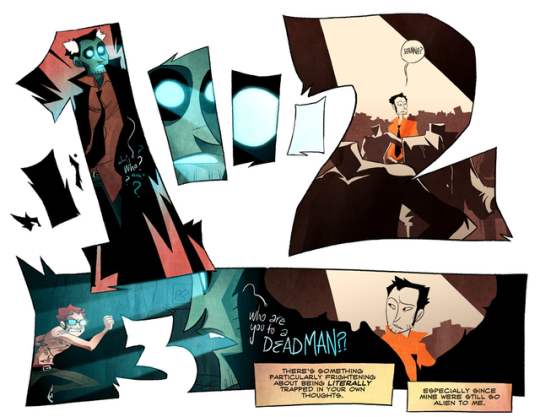
Basic advice: really really take your time taking in art that you like, and try to reverse-engineer how it was made in your head. Heck, even if there's art you DON'T like, overall, but has elements you DO like, you can learn from that, too!
Okay! Sorry for rambling! Now here's the thing you're actually here for:
How To Think When You Draw collection of REALLY GOOD tutorials for whatever you need, these guys helped me out a ton when I was figuring the jungle scenes early in Infested.
This Pinterest Which Has Absolutely Everything You Can Possibly Think Of For References And Inspiration Sources.
An Extremely Good Font Site That Is Used By Professionals In The Comics Industry To Letter Their Comics.
The Most Important Book Any Cartoonist Can Read
A Different Book By The Same Man About Making Comics (for free, thanks Internet Archive)
Perspective For Comic Book Artists, thanks again Internet Archive
As for workflow... Man, I wish I could give you any kinda advice on that. I'm struggling with it, myself. I guess I've got two things?
If you have multiple deadlines for, say, multiple commissions or something, or you're trying to put out a weekly comic, but you're also doing something else, break the day up into time slots for each project, and switch the moment it's time to. Keep yourself on that schedule. I'm not very good at this.
I draw pretty detailed thumbnails, so sometimes I'll skip the penciling step in comics and blow up the thumbnail to ink over that. It's faster for sure! It's not always the right solution, however.
Thanks for reading! I hope any of what I've said helps at all!
40 notes
·
View notes